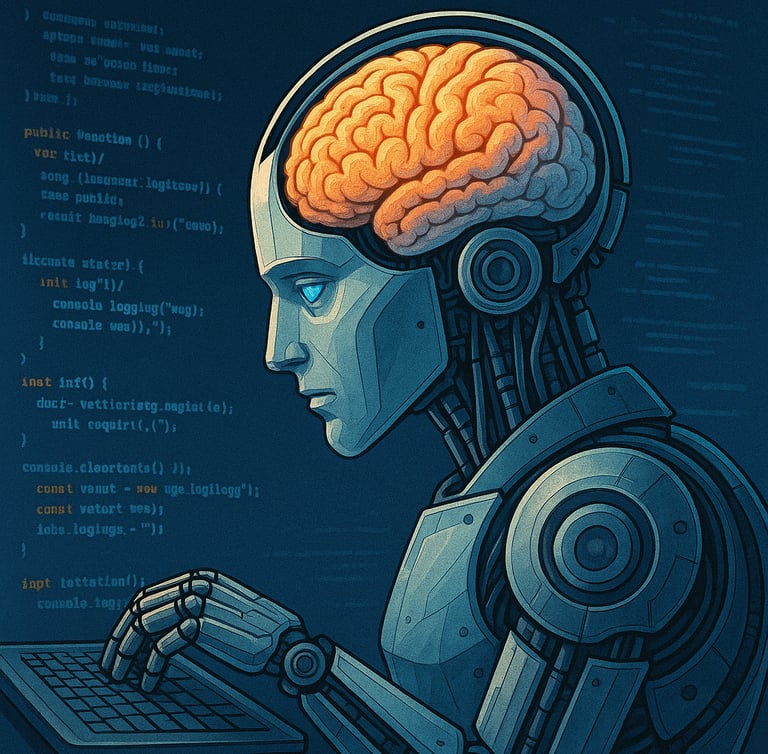This AI Wrote 20% of Microsoft’s Code—In Seconds. Developers Call It ‘Uncanny’
Behind the scenes at Microsoft, nearly a third of the company’s codebase is now written by AI. Developers are stunned — and the consequences might outpace even the boldest predictions.


It was just another Thursday in Redmond. A product team at Microsoft committed a batch of code changes. Nothing new — except that this time, more than a quarter of the new lines weren’t written by a human. They were drafted, refined, and pushed by AI.
According to CEO Satya Nadella, as of early 2025, AI tools like GitHub Copilot and OpenAI Codex are responsible for up to 30% of the code across Microsoft’s software repositories. In Python-heavy areas like Azure and Teams, that figure is even higher.
“I didn’t write that function,” one senior developer said, laughing, “but I reviewed it, tweaked it — and shipped it. The AI’s first draft was... uncanny.”
How Did We Get Here?
The adoption of AI in coding isn’t exactly new. But the leap in quality is. What began as clunky autocomplete has evolved into fluid, multi-line logic builders. Tools like GitHub Copilot now predict not just the next token, but the entire intent of a method.
And developers are responding. In a 2025 controlled trial involving over 900,000 Copilot users, researchers found that developers completed tasks up to 55% faster when using AI assistants — especially for repetitive or low-level code.
But speed has a cost. And some developers are starting to ask: are we just copying? Are we thinking less?
The Productivity Paradox
Junior developers praise the tools. One said, “It’s like a second brain. I feel more confident trying new frameworks.” But some senior engineers are less enthusiastic.
“It’s not about writing code anymore,” said an architect at a Fortune 500 firm. “It’s about asking the right questions. That’s a bigger shift than people realize.”
And sometimes, the suggestions are wrong — subtly so. Researchers at MIT and Microsoft found that AI-generated code is more likely to contain security vulnerabilities when users accept suggestions too quickly.
Coding Becomes Collaboration
At the 2025 Microsoft Build conference, Copilot’s new “agentic mode” was unveiled. It doesn’t just suggest lines — it builds, tests, and even comments on code. The AI now behaves like a junior developer on your team.
Some teams report that AI tools now draft over 50% of initial code before humans take over for refinement and integration. The feedback loop is fast, iterative, and eerily creative.
“It’s like brainstorming with a colleague who never sleeps,” said one GitHub engineer. “Sometimes it nails it. Sometimes it misses entirely. But the fact that it tries is revolutionary.”
What’s the Catch?
AI-generated code can be fast and impressive, but it’s not always right. Developers still need to evaluate logic, test thoroughly, and monitor for unexpected behaviors. In 2025, GitClear found that teams relying heavily on Copilot showed increased volumes of duplicated or disposable code — a sign of lower-quality contributions that had to be reworked.
“We're seeing more commits,” a CTO told Visual Studio Magazine, “but not always better ones. AI helps you ship faster. But it also makes it easier to ship junk if you’re not paying attention.”
The Future of the Developer Role
What happens when AI writes most of the boilerplate, handles testing, and even suggests architecture?
Developers become curators. They’re evolving into prompt engineers, pattern spotters, and critical reviewers. The code may come faster — but the skill of shaping and directing it becomes even more crucial.
And for now, at least, the AI doesn’t understand context, nuance, or business logic. “It’s a brilliant parrot,” said one developer. “But I’m still the one giving it the script.”
Conclusion
Yes — AI now writes a shocking amount of Microsoft’s code. But beneath the hype, the human element hasn’t vanished. It’s transformed. Developers aren’t obsolete — they’re being asked to think higher, faster, and more critically than ever.
That’s not a loss. It’s a challenge. And maybe even an opportunity.
Sources:
Microsoft CEO Satya Nadella’s remarks at Meta AI event (April 2025): TechCrunch
GitHub Copilot user impact study: arXiv.org (2306.15033)
MIT + Microsoft vulnerability risk paper: Business Insider
GitClear 2025 code quality study: GitClear Report
Visual Studio Magazine – Copilot efficiency concerns: VSM
WSJ & Financial Times coverage of ‘vibe coding’: WSJ
info@konsultbiz.com
© 2025. All rights reserved.
Disclaimer: All articles represent the author’s views. Although efforts are made to ensure accuracy, no liability is accepted for any errors or misstatements. Please contact us immediately if corrections are needed before taking any legal or public action.


